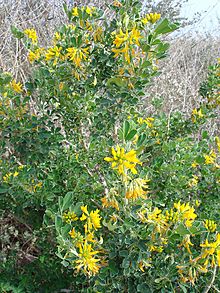
Medicago is a genus of flowering plants, commonly known as medick or burclover, in the legume family (Fabaceae). It contains at least 87 species and is distributed mainly around the Mediterranean basin. The best-known member of the genus is alfalfa, an important forage crop, and the genus name is based on the Latin name for that plant, medica, from Greek: μηδική (πόα) Median (grass). Most members of the genus are low, creeping herbs, resembling clover, but with burs. However, alfalfa grows to a height of 1 meter, and tree medick is a shrub. Members of the genus are known to produce bioactive compounds such as medicarpin and medicagenic acid. Chromosome numbers in Medicago range from 2n = 14 to 48.

Medicago truncatula, the barrelclover, strong-spined medick, barrel medic, or barrel medick, is a small annual legume native to the Mediterranean region that is used in genomic research. It is a low-growing, clover-like plant 10–60 centimetres (3.9–23.6 in) tall with trifoliate leaves. Each leaflet is rounded, 1–2 centimetres (0.39–0.79 in) long, often with a dark spot in the center. The flowers are yellow, produced singly or in a small inflorescence of two to five together; the fruit is a small, spiny pod.

Ipomoea tuberculata is a flowering plant species in the bindweed family (Convolvulaceae). It belongs to the morning glory genus, Ipomoea.

Medicago lupulina, commonly known as black medick, nonesuch, or hop clover, is a plant of dry grassland belonging to the legume or clover family. Plants of the genus Medicago, or bur clovers, are closely related to the true clovers (Trifolium) and sweet clover (Melilotus). Like the true clovers, black medick has three leaflets and a small, yellow flower closely resembling those of lesser trefoil. Black medick belongs to the same genus as alfalfa.
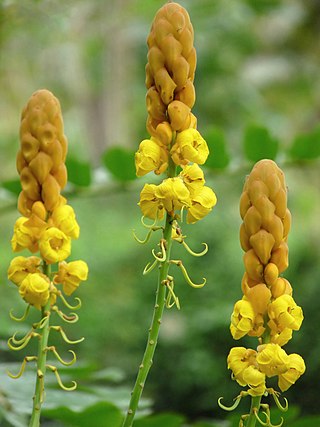
Senna alata is an important medicinal tree, as well as an ornamental flowering plant in the subfamily Caesalpinioideae. It also known as emperor's candlesticks, candle bush, candelabra bush, Christmas candles, empress candle plant, ringworm shrub, or candletree. A remarkable species of Senna, it was sometimes separated in its own genus, Herpetica.
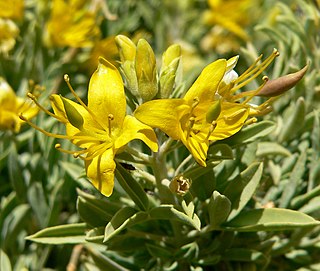
Cleomella arboreasyn. Peritoma arborea, is a perennial shrub or bush in the spiderflower family (Cleomaceae) known by the common names bladderpod, bladderpod spiderflower and burro-fat. It has yellow flowers in bloom all months of the year. It emits a foul odor to discourage herbivory from insects.
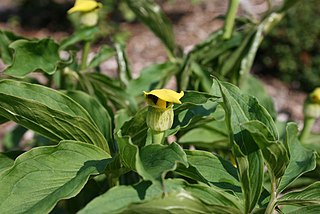
Arisaema flavum is a species of flowering plant widespread across north-eastern Africa and southern Asia. It is native to Ethiopia, Somalia, the Arabian Peninsula, Pakistan, Afghanistan, Nepal, Assam, Himalayas, Tibet, Yunnan, and Sichuan. The species epithet flavum is Latin for yellow and indicates its flower colour.

Hippocrepis emerus, the scorpion senna, is a species of perennial plant belonging to the genus Hippocrepis in the family Fabaceae.

Arisaema erubescens is a flowering plant species in the genus Arisaema, endemic to Nepal.

Cotoneaster glaucophyllus, commonly known as glaucous cotoneaster' or bright bead cotoneaster, is a native plant of China and the Himalayas.
Melica commersonii is a species of grass endemic to Chile.
Melica longiligulata is a species of grass endemic to the Sichuan province of China.

Agrostis vinealis is a species of grass known by the common names brown bentgrass and brown bent, which can be found from Russia to Mongolia, China, Pakistan, India and Alaska. It was introduced to Greenland and South Georgia and the South Sandwich Islands.
Pentaphylax euryoides is a species of flowering plant in the Pentaphylacaceae family that can in be found on Sumatra and in such countries as Malaysia, Vietnam and China. In China, it is found in such provinces as Guangdong, Guangxi, Guizhou, Hainan, Yunnan, and in southern parts of Fujian, Hunan, and Jiangxi.
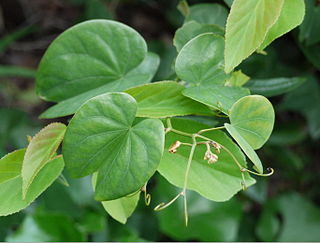
Bauhinia japonica is a species of flowering plant in the family Fabaceae which can be found in Guangdong, Hainan and Japan.

Quercus baloot, the holm oak or holly oak is a rare species of oak that was described by Griffith in 1848. It is classified in subgenus Cerris and section Ilex. It is native to the Himalayas from 1,000–3,000 metres (3,300–9,800 ft).

Betula chinensis, commonly known as dwarf small-leaf birch, is a species of birch that can be found in China and Korea on the elevation of 700–3,000 metres (2,300–9,800 ft).
Zanha africana, the velvet-fruited zanha, is a species of fruit plant from the family Sapindaceae which can be found in Angola, Kenya, Mozambique, Zimbabwe, and the Democratic Republic of the Congo where it is used in door frames and tool handles. It is also used for flooring and for creating toys, railway sleepers, turnery, furniture and ship designs.
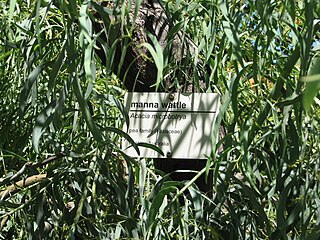
Acacia microbotrya, commonly known as manna wattle or gum wattle, is a shrub or tree belonging to the genus Acacia and the subgenus Phyllodineae that is native to Western Australia.
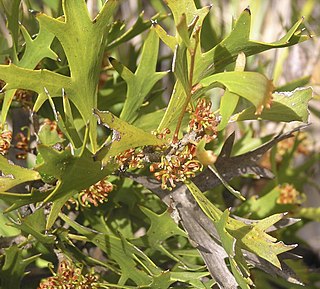
Hakea ceratophylla, commonly known as the horned leaf hakea, is a shrub in the family) Proteaceae and is endemic to the southwest of Western Australia. It is a stiff shrub with variably-shaped leaves that are sometimes lobed and flowers with white or rusty-coloured hairs.
